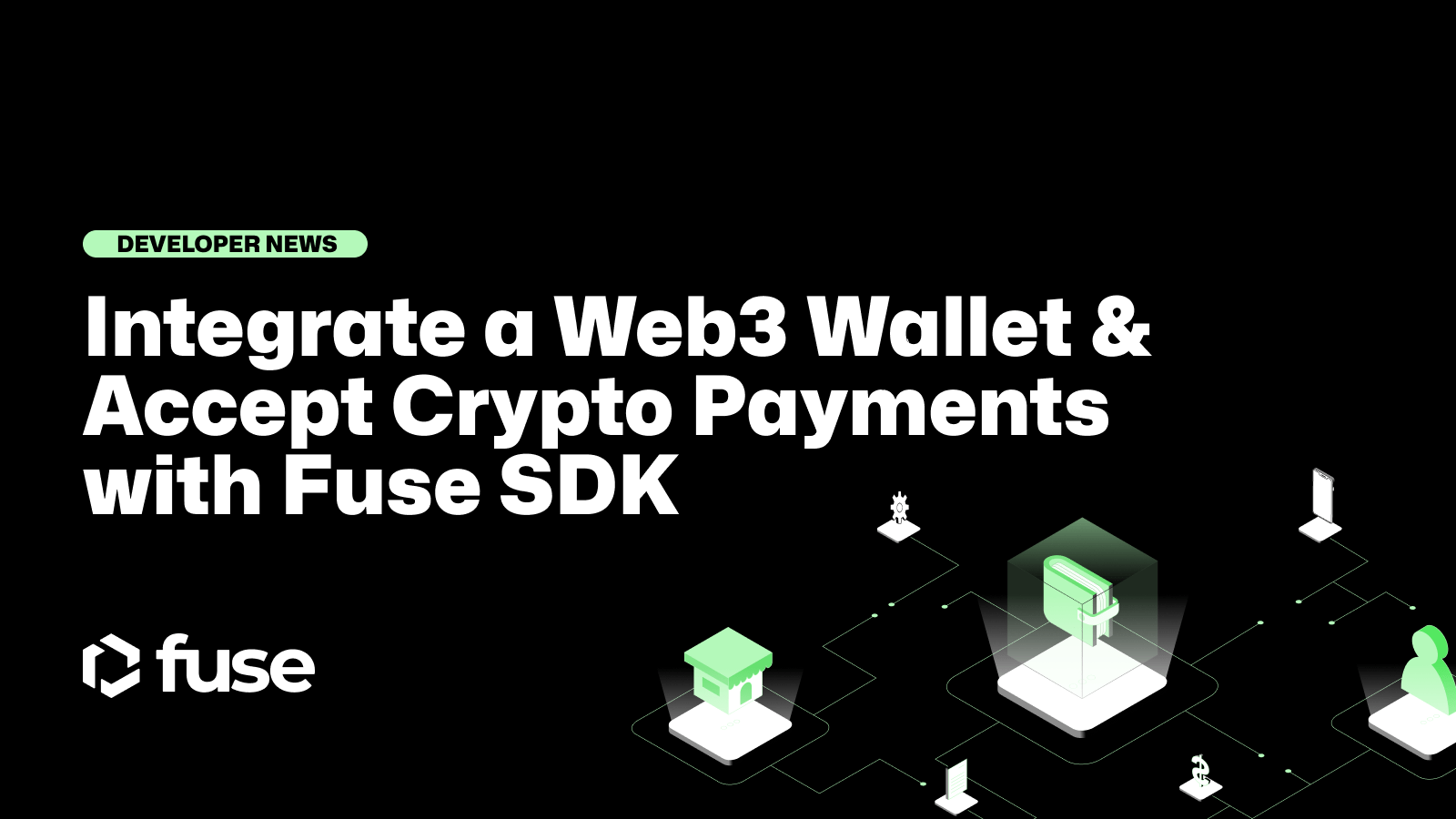Integrating a Web3 wallet and accepting crypto payments became much easier with the overhauled Fuse SDK.
In 2023, the number of merchants looking to embrace and accept crypto payments and build Web3 wallets surges to new highs. According to a recent report by Checkout.com, more than 75% of merchants who accept crypto payments celebrate increased sales globally.
Unsurprisingly, around a quarter of all online businesses are looking to embrace crypto payments by 2025 – a number that will only grow as the benefits become widely known. There’s been a surge in people wanting to use cryptocurrencies for payment. Growth looks to continue, with around 40% of 18-35-year-old consumers showing an appetite to experiment with crypto as a payment method.
More importantly, with its new SDK, Fuse is well-positioned to provide businesses with the means to add crypto payments to their current apps and services.
Remove blockchain difficulties
Companies are looking for ways to start integrating Web3 payment features into existing mobile applications without teaching users new behaviors or dealing with complex blockchain actions like a private key or secret recovery phrase.
The Fuse Wallet SDK abstracts away the complexities of Web3 development, such as cryptography, wallet management, and smart contract interactions, making it easier for developers to build blockchain-based applications.
The SDK is designed to make it easy for developers to create, manage, and engage with Fuse Smart Wallets in their Flutter and TypeScript applications. Fuse Smart Wallets are smart contract wallets associated with each user’s Externally Owned Account (EOA) that provide added security compared to traditional EOAs with a single private key.
With Fuse Smart Wallets, users can deposit funds that no one else can control and withdraw at any time. The SDK provides pre-built functions and utilities, allowing developers to interact with Fuse Smart Wallets securely and efficiently.
What can the SDK do?
The Fuse Wallet SDK provides several features that allow developers to create, manage, and engage with Fuse Smart Wallets in their applications. At the time of writing, The Fuse Wallet SDK is available for Flutter/Dart, with a Typescript SDK planned for release shortly.
Some of the key features include:
- Create a Fuse Smart Wallet: Create a new Fuse Smart Wallet associated with a user’s EOA.
- Retrieve an existing Fuse Smart Wallet: Retrieve an existing Fuse Smart Wallet associated with a user’s EOA if it exists.
- Send transactions: Send transactions, including ERC20 and NFT transfers and interaction with arbitrary smart contracts, through the Fuse relayer that will cover the gas fees. This allows users to interact with the blockchain without worrying about gas fees and send and receive crypto payments.
- Retrieve transactions history: Retrieve a user’s transaction history for their Fuse Smart Wallet. This makes it easy to keep track of their activity on the blockchain.
- Retrieve ERC20 and ERC721 token balances: Retrieve a user’s ERC20 and ERC721 token balances for their Fuse Smart Wallet. This makes it easy to monitor their holdings on the blockchain.
- Staking: Let Smart Wallet owners stake their native FUSE tokens directly in the app and earn rewards.
- Trading and DeFi: Let users swap tokens on Fuse Network and access DeFi services.
Several of the most powerful features of the SDK avail themselves in the UX. As it’s here, crypto and blockchain applications have struggled to onboard users with new behaviors, such as private keys. Simply put, Web2 users are conditioned to be able to reach out to a customer support agent if they lose access to an account and are not used to such high levels of responsibility. In the decentralized blockchain world, it’s not so simple. as there are no centralized gatekeepers.
However, because of Fuse’s proprietary Smart Wallet tech, the Fuse SDK lets you build apps with account abstraction, gasless transactions, and the ability to let end-users retrieve an existing wallet. Moreover, wallets and private keys are handled in the background while users sign in using a familiar social login like Google.
This way, developers bring Web3 features into their existing applications or online services to start accepting crypto payments and developing community-based economies around loyalty and rewards.
For example, a UK-based project called YourGaff uses the Fuse SDK to build a wallet capable of handling customers’ rental and deposit transactions. It then rewards users with 10% of their rent back in its native token to say thanks for adopting the new system.
Likewise, Bitazza, a multi-faceted crypto company based in Southeast Asia, uses the Fuse SDK to build its freedom wallet. This technology was then sold to Thailand event organizers and travel companies to orchestrate ticketing and customer retention mechanisms using NFTs.

The Wallet SDK works only on the Fuse Network, an EVM-compatible L1 blockchain. Support for other blockchains is planned for the future. To learn more about how to start with the Fuse Wallet SDK, an overview of its architecture, and frequently asked questions, head to our Docs.
If you have any questions or feedback, please contact our support team.
Accept crypto payments
Another hurdle to businesses embracing crypto payments and Web3 wallet features is understanding how things will work for end-users. The flow of the application is significant to onboarding and retention. When a user wants to pay a merchant, the following steps take place:
- The user opens the application developed by an Operator and initiates the payment flow through the application.
- The Operator’s application signs the transaction behind the scenes with the user’s private key and relays the signed transaction to the Power Validators network using Fuse-SDK.
- Power Validators receive such transactions, validate them, bundle them, and relay them to the blockchain network.
- The transactions are confirmed by the validators and added to blocks.
- The merchants receive the funds in their wallets.
The process will be as frictionless as possible for end users and merchants. To learn more about entities and roles in the Fuse Network ecosystem, head to our Docs.
The services to make it work
Client applications are the applications in which the SDK is utilized to make the abovementioned crypto payments flow possible. It’s also responsible for utilizing other solutions for authenticating users and securing their private keys to sign and authorize the transaction requests off-chain on the client side. They can also utilize or implement extra features like payment links to pay for products and services online or notify the end-users with push notifications when they receive payments.
APIs and the SDK enable creating and managing wallets for the users and the merchants, sending transactions to the blockchain through the relayers, and notifying the client application about the statuses of the transactions with events. Meanwhile, the relayer receives transaction requests, verifies them, and submits them to the blockchain by covering the gas fees.

Future Fuse SDKs
In addition to the current Flutter SDK, we plan to release additional SDKs for other popular languages and frameworks. These SDKs will allow developers to integrate Fuse Smart Wallets into their applications seamlessly.
Upcoming SDKs and their planned release dates:
- React Native SDK (planned release: Q3 2023)
- Python SDK (planned release: Q4 2023
Integrating a Web3 wallet and accepting crypto payments became much easier with the overhauled Fuse SDK.
.svg)
.svg)












